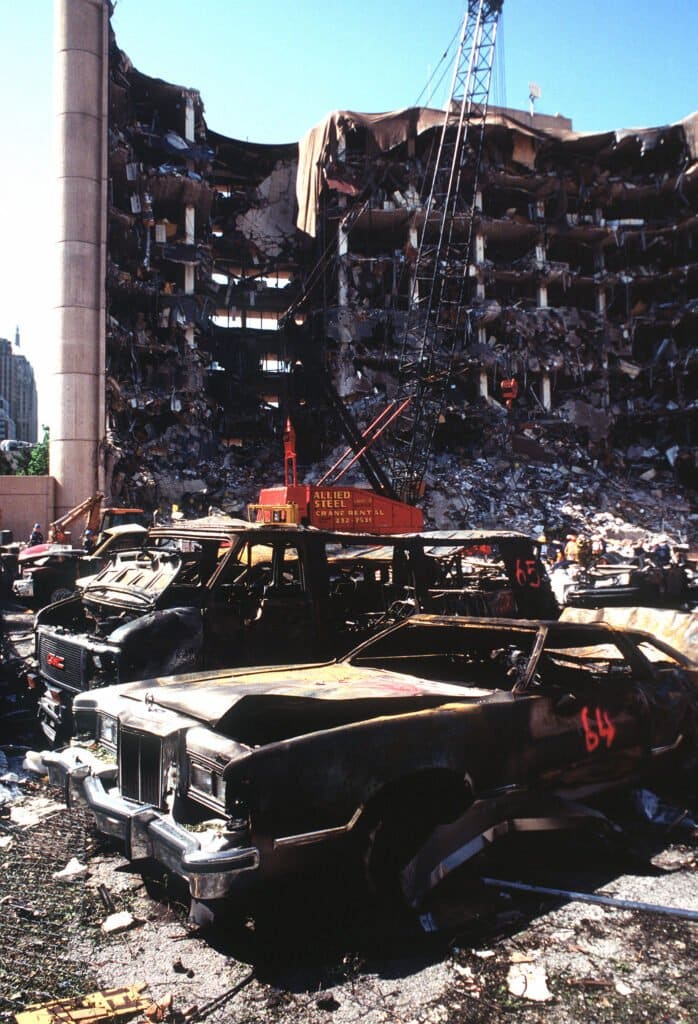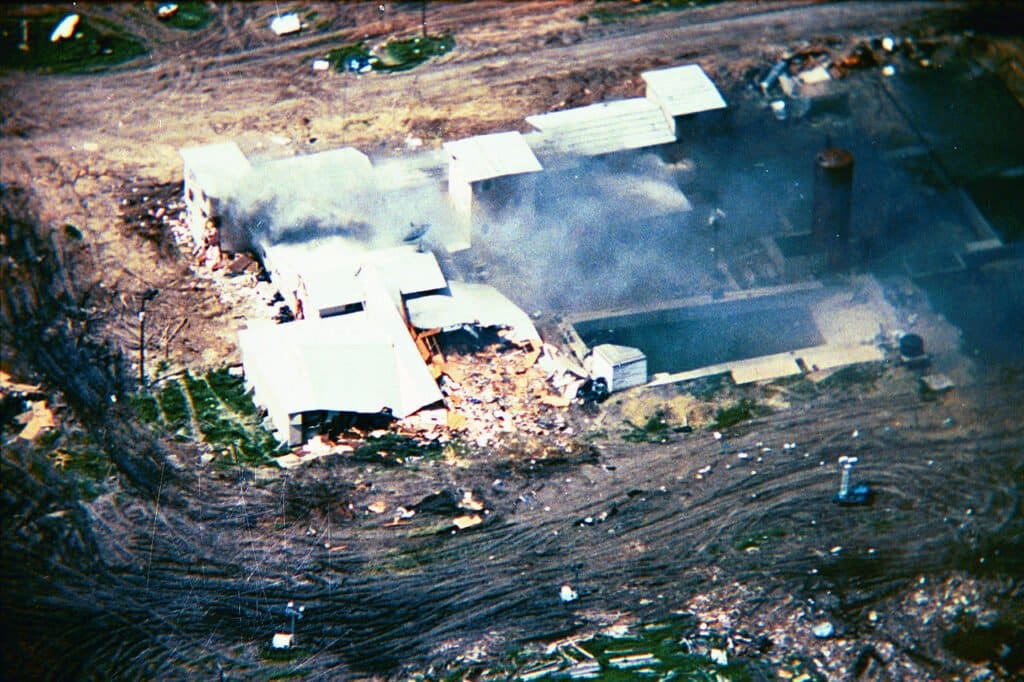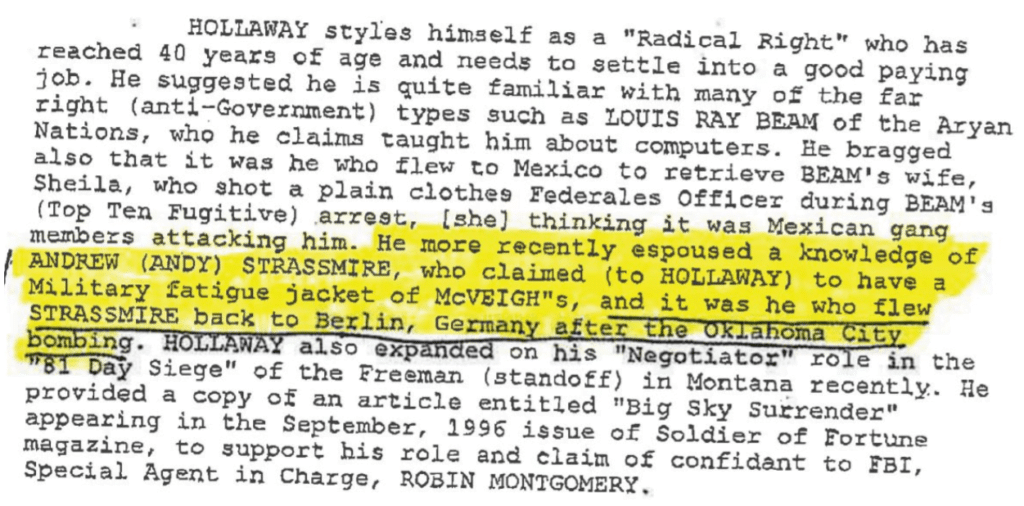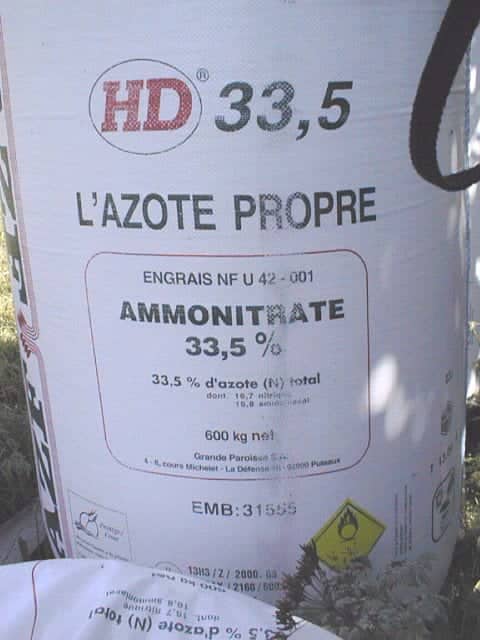As the 27th anniversary of the Oklahoma City Bombing approaches, many are reminded of the April 19th 1995 tragedy and the first-ever mass-casualty terrorist attack on American soil – six years before the events of September 11th.
Killing 168 people, 19 children, and injuring over 680 others, the prologue to a new chapter in American History had been written in blood, fear and dismay. Terrorism had struck home and nothing would ever be the same again.
Timothy James McVeigh, the U.S. Army veteran who drove the ammonium nitrate bomb disguised as a Ryder rental truck to Oklahoma City, parked outside the Alfred P. Murrah Federal Building, lit the fuse and walked two blocks until he heard the blast at 9:02 am.
To the public’s dismay, the Oklahoma City bombing presents us with layers that reach far beyond the prism of a tightly knit lone bomber story. But McVeigh also left traces of his mystery within the inner sanctums of anti-government propaganda.
- Advertisement -
But what was initially broadcast as a simple evil act perpetrated by an enraged individual, conflicted by the American government’s mishandling of the Waco siege, transformed into one of the most definitive examples of an American story tangled in deception, fabrication and misinformation.
The official story
A 26-year-old McVeigh awoke in the early hours on April 19th 1995 from his Dreamland hotel room located near Fort Riley, Kansas City and headed for Oklahoma City. A 280-mile drive; all while operating a Ryder Rental Truck housing 1,200 pounds of ammonium nitrate and fuel oil.
At 9:02 am that same morning, an explosion tore through the entire north face of the Murrah Federal Building. The glass facade that once wrapped the building’s structure instantly exploded – crumbling with rubble, dust and debris.
Amongst the grey ash layover 680 injured people and 168 dead bodies. However, early eyewitness testimony, along with the footage, shows federal agents removing boxes of documents along with firearms from the rubble. All while victims of the horrendous attack lay amongst the debris.

Within 90 minutes of the explosion, McVeigh was pulled over by a highway patrol officer, 60 miles north of Oklahoma City for speeding in a yellow Mercury Grand Marquis without a licence plate.
The first time McVeigh had been arrested in his life, forensic evidence quickly linked McVeigh and his accomplice, Terry Nichols, to the attack. Nichols was arrested and within a matter of days, both were charged with at least one of the following: Conspiracy to use a weapon of mass destruction, use of a weapon of mass destruction, destruction by an explosive of government property and first-degree murder.
While Nichols was identified as an accomplice to the bomb’s preparation, it was said by law enforcement at the time that McVeigh had timed his attack to coincide with the second anniversary of the siege at the Branch Davidian compound.
Attorney general Janet Reno, along with President Bill Clinton, had announced that domestic terrorism had struck the heartland of America. From that day forward, the Oklahoma City bombing was named the deadliest act of domestic terrorism in U.S. history.
- Advertisement -
Who was Timothy McVeigh?
Born in Pendleton, upstate New York, McVeigh was the middle child of Bill and Mickey McVeigh. Raised in a rural state in a blue-collar family, the self-identified quasi-survivalist always had a passion for firearms and survival. He spent his childhood endeared by the wilderness of the American northeast.
After graduating high school in June of 1986, McVeigh spent a short period at a local business college whilst working various jobs. McVeigh eventually enlisted in the U.S. Army in 1988 and proved to be a model soldier, earning a Bronze Star for bravery in the Persian Gulf War.
It was around this time that he began reading the book that would change his life forever – The Turner Diaries, a famous anti-government disquisition written by Dr William Luther Pierce. The book, which details a truck bombing of the FBI’s headquarters, fueled McVeigh’s paranoia about a government plot to repeal the Second Amendment of the United States Constitution.
During his tenure at Fort Riley, Kansas, McVeigh was posed as a strong candidate for the special forces group the exclusive green beret – his dream military assignment.
One week later at Fort Bragg, North Carolina, McVeigh began strenuous training. But to his dissatisfaction, McVeigh was not the soldier he once was – or so he claims. McVeigh left the program after just two days, taking an early discharge and eventually leaving the army in late 1991.

The Waco Siege
In March of 1993, just outside Waco, Texas, the Branch Davidians led by David Koresh experienced a six-day siege with the FBI, ATF, and DEA. The Bureau of Alcohol, Tobacco and Firearms, using armed agents, attempted to execute a search and arrest warrant for possession of illegal weapons against the Branch Davidians.
Six Branch Davidians and four agents were killed, soon turning the event into a 51-day stand-off. A 24-year-old Timothy McVeigh travelled to witness the standoff at the Mount Carmel centre, 20 miles northeast of Waco, Texas.
McVeigh was interviewed by Michelle Raunch, a local journalism student, who photographed a confident McVeigh selling pro-gun, anti-government and pro-patriotism bumper stickers outside the standoff.
- Advertisement -
On April 19th, the FBI and U.S. Army attacked the Branch Davidian compound. Tanks rammed holes into its walls, CS gas filled the entire settlement and pyrotechnic devices fired into the building that soon became a raging inferno. An enraged McVeigh watched the television from the Nichols Michigan farm in utter indignation, as reports of the Waco siege were broadcasted.

In his 1997 interview, McVeigh spoke about his Waco experience: “I’m watching flames lick out windows and I’m watching tanks ram walls, and my eyes welled up in tears. Tears started coming down my cheeks as I watched the scene unfold.”
“Koresh wasn’t giving in, that’s true. But the FBI were the aggressor. Everything they do exudes that they are a military force at war with the American people,” said McVeigh. “Waco started this war – hopefully Oklahoma would end it.”
‘Sheep-dipped operative’
Timothy McVeigh claimed he was honourably discharged from the Army in 1991, three years before the Oklahoma City bombing – supposedly leaving behind an exemplary service record. But interestingly, after McVeigh pronounced himself unable to continue just two days into special forces training, he returned to his unit devitalised, or as some reported – a “changed man.”
In 1993, one and a half years after McVeigh’s discharge, Bill Bean, an amateur film director, recorded footage that supposedly shows McVeigh in military uniform.
Bean was scouting for filming locations at Camp Grafton, the North Dakota National Guard training centre at the time.
Beyond the strong physical resemblance, professor Michael Blomgren, a speech pathologist at the University of Utah, conducted a voice analysis comparison of Bean’s footage to McVeigh’s 2000 60 minutes interview. Professor Blomgren came to an 86% voice match conclusion.
This led many investigators to believe McVeigh was a “sheep-dipped operative.” A term commonly used in the intelligence community to describe a person who has been given an alternate identity.
- Advertisement -
But how exactly did McVeigh hold the characteristics of a sheep-dipped operative? Similar to Lee Harvey Oswald in his espousal of pro-communist ideology during his military service, McVeigh had abruptly begun espousing anti-government beliefs through the prism of The Turner Diaries. This made McVeigh a prime candidate for deep-state operations.
Furthermore, in his sworn declaration, Nichols testified that McVeigh told him that he had been recruited to perform undercover covert missions while in the army.
The letter
Famously, McVeigh wrote a letter to his sister in 1993, published by the New York Times in 1998, in which McVeigh left a telling message regarding his connections to U.S. intelligence:
“Now here’s what led to my current life: It all revolves around my arrival at Ft. Bragg for Special Forces. We all took intelligence, psychological, adeptness, and a whole battery of other tests. One day in formation, ten Social Security numbers were called out. Mine was one,” wrote McVeigh.
Adding, “The 10 of us were told that out of the select group of 400, we had scored highest on certain tests. We were all asked to ”volunteer” (talk about peer pressure!) to do some work for the government on the domestic, as well as international, front.”
“What I learned next, both from the briefings, and from the questions and private talks included: We would be helping the CIA fly drugs into the U.S. to fund many covert operations. Military ‘consultants’ were to work hand-in-hand w/civilian police agencies to ‘quiet’ anyone who was deemed a ‘security risk.’ (We would be gov’t-paid assassins!),” wrote McVeigh.
Jennifer McVeigh later turned the letter over to the FBI during their investigation. This clue written by McVeigh himself remains one of the most significant exhibits in the overall investigation.
Foreign connections
Andreas Strassmeir AKA “Andy the German,” son of Günter Straßmeir, the chief of staff to German Chancellor Helmut Kohl, studied at a military university in Hamburg. Strassmeir went on to serve in the German military in 1979 but more specifically, he studied at the explosives and weapons training department for five years.
- Advertisement -
Arriving in the United States in the early 1990s, Strassmeir began professing neo-nazi beliefs after arriving in Elohim City, a separatist compound in eastern Oklahoma to which Strassmeir was appointed chief of security.
ATF informant, Carol Howe, testified in court that Strassmeir made threats of bombing federal buildings and assassinating public officials. Straussmeir left Elohim City immediately after the Oklahoma City bombing and was reportedly flown back to Germany by the CIA.

Still alive today and residing in Germany, very few investigators can definitively say what Strassmeir’s part in the bombing was – if any at all. However, considering McVeigh’s phone calls to the German, it is believed that the two collaborated on the bombing plot.
Dr Louis Jolyon West
Dr Louis Jolyon West, a shadowy CIA affiliate, was a leading psychologist and psychoanalyst in Northern America. Dr West was known to be the number two under Dr Ewan Cameron throughout the CIA’s infamous LSD mind control program, MK-Ultra.
Dr West continued his research into hypnosis, terrorism and occults, even consulting and later writing about the Waco siege. Records clearly show that Dr West consulted McVeigh’s defence team during his federal trial. Interestingly, Dr John Smith (his actual name), a protege of Dr West, happened to be McVeigh’s doctor in prison.
The trial
As told by Dale Philips of the Oklahoma Bombing Investigation Committee (OKBIC): “The trial was not handled appropriately. It was handled in a way that was very prejudicial against the defendants.”
Phillips also noted, “If you look at what Judge Matsch did concerning prejudicing the jury toward the people that were being prosecuted. Within two weeks of McVeigh’s federal trial, he had shown the jury photographs of dead victims, blood and guts. It is my understanding that it is illegal to prejudice a jury like that.”
Jannie M. Coverdale, whose grandsons were two of the 19 children to have tragically died as a result of the bombing, has always been a key voice in uncovering the hidden truths surrounding the 1995 tragedy, until her death in early 2022.
- Advertisement -
“I was told by the U.S. district attorney that if I attended the trials in Denver that all of my questions would be answered. But by the time Terry Nichos’ trial was over, I had more questions, and no answers,” Coverdale said.
In contrast, the trial of O.J. Simpson in 1995 lasted 9 months. However, in McVeigh’s trial, the jury deliberated for less than 24 hours and sentenced him to death. McVeigh waved all his appeals and eventually fast-tracked to be the first federal prisoner executed since 1963.
Just before his execution date in May of 2001, the FBI announced they had withheld thousands of documents from McVeigh’s defence team. Attorney General Ashcroft then announced McVeigh’s execution date would be postponed for 30 days – leading to a month-long state of execution.
Leaving no final words and deeming himself the winner in his war against the government, on June 11th 2001 at 7:14 am, Timothy McVeigh was put to death by lethal injection and cremated without an autopsy.
Although Nichols was found guilty and sentenced to 161 consecutive life sentences, the jury refused to give Nichols the death penalty. They were convinced the federal government failed to produce satisfactory evidence in regard to “the others unknown.”
Charles Key, former Oklahoma state representative and the founder of the OKBIC, spoke in a live broadcast after Nichols trial had ended, saying: “I think what [the jurors] statement says is that they knew there was something wrong and somebody had some involvement here. As they said so themselves – there were lies and mistruths.”
The Oklahoma Bombing Investigation Committee (OKBIC)
In the absence of official action, a group of concerned heads decided to form an investigative panel dubbed The Oklahoma Bombing Investigation Committee (OKBIC).
Searching long and hard for answers that the Federal Government failed to acknowledge, the committee made exceptional discoveries during their investigation. Funded out of their own pockets, the OKBIC took affidavits, recorded eyewitness testimony and paid for private investigators to chase down significant leads. As a result, we now have access to an entire miscellanea of legal material, the likes of which were initially swept under the rug.
- Advertisement -
Consisting of Charles Key, Dale Phillips, Colonel Wallace and Oklahoma bombing survivor V.Z. Lawton, the committee fought the American government at every level – all the way through to the supreme court of the state. Through their efforts, the committee successfully formed the Oklahoma County grand jury (a law exclusive to few American states), in an attempt to hold a public investigation.
Three weeks before the events of September 11th, the committee released a collection of their investigational works in the book titled, “The Final Report on the Bombing of the Alfred P. Murrah Building.” The report was an ultimate success, so much so that media coverage was awaiting its arrival to get a taste of the details.
In the words spoken by state representative Charles Key: “The reason we did this is because if you don’t ask the questions and you don’t hold the government accountable, then you’ll have the same mistakes happen again, and they will get worse as time goes on.”
‘Bludgeoned to death’
On the morning of the bombing, Sergeant Terrence Yeaky was issuing a traffic ticket to a female driver four blocks west of the Murrah Building. After hearing the bomb blast at 9:02 am, Yeaky dropped the ticket, let the woman go and sped to the site of the explosion in his black and white squad car.
As the OKBIC uncovered, Yeaky had accumulated early knowledge of suspicious activity occurring in Oklahoma. One day before the bombing, Yeaky reportedly said to his friend: “I’ve gotta run out and put stuff in mini storage, and as soon as I shake these Feds that are following me, I’ll be back and we’ll go to dinner.”
But shockingly, Yeaky never returned. Instead, his car along with his body was found by a county sheriff’s deputy outside the gates of El Reno penitentiary the next day with his death ruled as a suicide.
Another murder victim connected to the bombing, Kenneth Trentadue, brother of a trial lawyer and former law professor Jesse Trentadue, was brutally bludgeoned to death while in FBI custody in an Oklahoma City Federal Transfer Centre holding cell. Kenneth was transferred to Oklahoma from San Diego, California.
So why did the FBI take Kenneth to Oklahoma City? Though unsubstantiated, McVeigh’s own words may shed light on this question.
- Advertisement -
As told by Jesse Trentadue in his interview with The Corbett Report, a few years after his brother’s death, Jesse received a call from McVeigh, who said: “When I saw your brother’s picture and heard about what happened to him, I want you to know that in my opinion, Kenneth was murdered by the FBI because they mistook him for Richard Lee Gutherie.”
Who was Richard Lee Guthrie?
Richard Lee Gutherie, AKA, “Wild Bill,” was a former navy seal who was one of the leading members of The Aryan Republican Army (ARA). Cosy with Andreas Strassmeir, AKA, “Andy the German,” Gutherie’s circle primarily consisted of Scott Stedeford, Peter Langan, Mark Thomas, Michael Brescia and Kevin McCarthy.
The group spent most of their time in prison for committing various crimes concerning their instructionist motivation, so much so that law enforcement famously dubbed the group “The Midwest Bank Robbers.” The group admitted they wanted to fund (by robbing banks) and cause an uprising in America against the Federal Government by blowing up federal buildings, killing federal agents, race riots and the like.
Moreover, Peter Langdon testified in an affidavit that the Aryan Republican Army had admitted to liabilities concerning the bombing.
PAT-CON
Project Patriot Conspiracy, or PAT-CON, uncovered by Jesse Trentadue, was an operation run by the FBI during the ‘90s in their efforts to infiltrate militia, neo-nazis and other like-minded groups that held critical opinions of the U.S. government.
PAT-CON’s mandate was to place federal informants within militia groups across the United States to help facilitate an uprising in America, according to legal documents. Jesse Trentadue stated in a 2011 interview that “Elohim City was a PAT-CON operation, and I think McVeigh was involved in it.”
A second bomb
Jane Graham, an employee at the Murrah Federal building at the time of the bombing, corroborated evidence of early reports made by local news that suggested a second bomb may have gone off. Many now believe explosives were also planted inside the building.
“You could feel the concrete floor actually rising up from underneath you. You could feel it coming up from the inside,” Graham said in her interview with Freemind Films. Other bombing victims declared that the sensation of the swaying building was similar to that of an earthquake. But why? The truck bomb merely created an air blast – not an explosion. But what exactly caused the explosion itself?
- Advertisement -
Don Browning of the OKCPD, who was present at the scene of the bombing stated in the same interview: “A blast does not turn corners. And it did look like there was a secondary explosion or a more intense explosion towards the east side of the building. That portion of the explosion basically cleared everything from the front of the building to the south wall.”
Dale Phillips of the OKBIC then stated, “A truck bomb just delivers an air blast, that’s all it does. It would break windows, that’s about it. But some of [the Murrah Buildings] columns were ripped up, shredded and tossed around.”
Police officer, Craig Roberts, also said, “I’ve worked some bombings in my time. And I looked at the [Murrah Federal] building and I knew that the damage done to that building couldn’t have come from a truck with ANFO in it.”
Contrary to the FBI’s report, three seismographs performed at the University of Oklahoma recorded a seismic event lasting eight to ten seconds, suggesting that it is likely two separate explosions may have occurred.
ANFO (NH4NO3)
If ANFO (NH4NO3), a free-flowing (loose poured) mixture of porous prilled Ammonium Nitrate and fuel oil, was used in Oklahoma City, then why did it not emanate the chemical characteristics of ammonium nitrate? The signature of an ANFO explosion is nitric oxide, a noxious gas. This led the OKBIC to believe that there was no fertiliser bomb, to begin with.
In contrast, the 50-gallon ammonium nitrate drums used in the 1970 bombing of Sterling Hall consisted of 2,000 pounds of ANFO. Every single person exposed to the university bombing of the campus hall had to be hospitalised due to the release of nitric oxide. But in Oklahoma, they didn’t.

Physicist Sam T. Cohen, the inventor of the neutron bomb, stated in a letter to an Oklahoma politician that he did not believe a fertiliser bomb was capable of destroying the Murrah building. Saying: “I believe that the demolition charges in the building that were placed inside at certain key concrete columns did the primary damage to the Murrah Federal Building. It would be absolutely impossible and against the laws of nature for a truck full of fertiliser and oil… no matter how much was used… to bring the building down.”
FBI crime lab agent turned whistleblower, Dr Frederick Whiehurst, testified in Terry Nichols’ trial that a fellow FBI chemist changed his findings and lied under oath after meeting with federal prosecutors.
- Advertisement -
The office of the inspector general investigated Whitehurst’s testimony and issued a report that concluded the FBI crime lab had improperly identified the characteristics of ANFO, the weight of the bomb, the detonation system and what kind of explosives were used.
A report compiled by the Eglin Air Force base laboratory, after investigating the blast effects from the bombing, concluded that “the damage at the Murrah federal building is not the result of the truck bomb itself, rather due to other factors such as locally placed charges within the building.”
Oklahoma will live on through history
So why do the events of 1995 still haunt America, 27 years on?
Perhaps because the government fought harder to cover its tracks, rather than produce the legal material necessary which resulted in contradicting their conclusions. Or rather, we are presented with a haunting ultimatum. The likes of which furnishes the possibility that the bombing was indeed the product of a deep-state sting operation gone wrong.
168 lives lost, 19 children and 680 physical injuries. Not one federal agent was left with so much as a scratch. But why? Why would any government want to behave this way towards its citizens?
During the ‘90s, there was a global political awakening of sorts. Before the bombing, congress tried – unsuccessfully – to pass the Omnibus Counterterrorism Act that expanded federal jurisdiction, concerning national security. But after Oklahoma City, congress passed the bill just months after the bombing. Later renaming it the Antiterrorism and Effective Death Penalty Act.
So we may never know the true story of the real Timothy McVeigh. But what we know for certain is – that the victims demand and deserve truth and justice. April 19th 1995 will live on in history, but its legacy and lessons must be rooted in truth. The mystery of Timothy McVeigh may well be as Gore Vidal told it:
“There is always the interesting possibility that he neither made nor set off the bomb outside the Murrah building. It was only later, when facing either death or life imprisonment, that he saw to it that he would be given sole credit for hoisting the black flag and slitting throats.”




